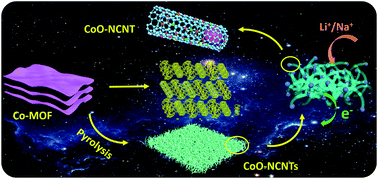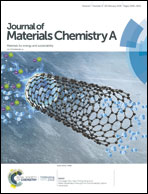MOF derived CoO-NCNTs two-dimensional networks for durable lithium and sodium storage†
Abstract
In this study, we report a two dimensional network through the combination of CoO nanoparticles and nitrogen doped carbon nanotubes (CoO-NCNTs) derived from a lamellar coordination polymer, ([CoII(2,3-chedc)(DABCO)0.5]), (2,3-chedc, cyclohexene-2,3-dicarboxylate; DABCO, 1,4-diazabicyclo[2.2.2]octane). During the pyrolysis of this two dimensional metal–organic framework (MOF), the NCNTs emerge accompanied with the catalysis of CoO nanoparticles and are connected to form two dimensional networks. The cobalt oxide particles are encapsulated and remain at the apical position of NCNTs. Due to the specific architecture and high content of CoO in the composite, it possesses great potential for lithium/sodium storage. Noticeably, high capacity and super long calendar life of 2000 cycles with only 0.0063% capacity loss per cycle is acquired for Li storage at a current density of 500 mA g−1. In addition, it also exhibits good sodium storage performance, which delivers a high capacity of 450 mA h g−1, and long cycling capability for 300 cycles with a capacity loss of 0.066% at a rate of 500 mA g−1. Remarkable performance emphasizes the great potential of the two dimensional MOFs for extensive utilizations in energy storage and transfer processes.

- This article is part of the themed collection: International Year of the Periodic Table : Low Dimensional Carbon Systems


 Please wait while we load your content...
Please wait while we load your content...